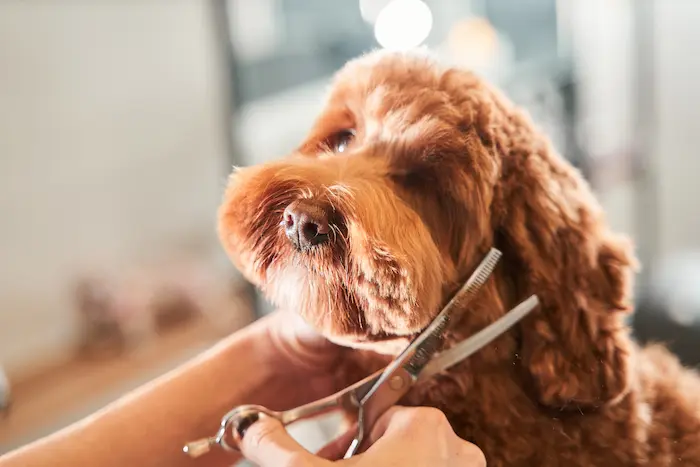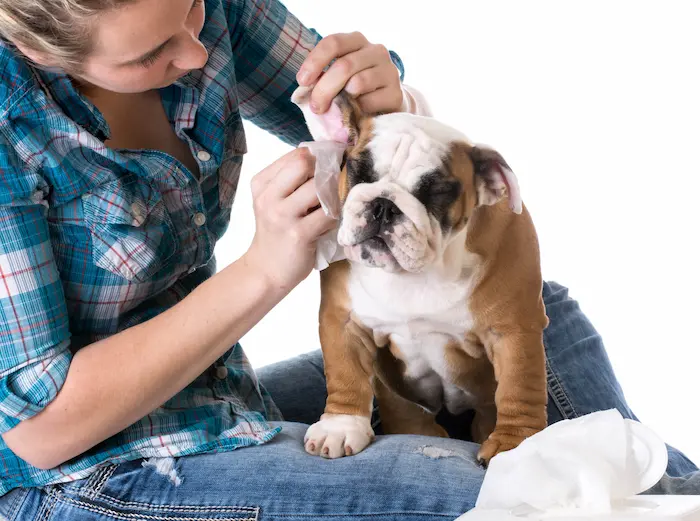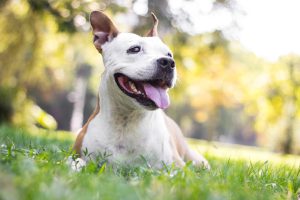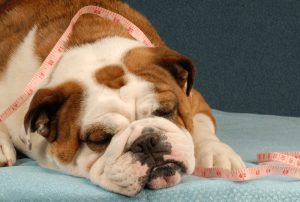
Dog Grooming: Why It’s Essential for Your Dog’s Health
Dog grooming is more than just making your furry companion look adorable. It’s essential to dog health and hygiene for several reasons. For starters, grooming services keep your pet clean, preventing dirt and debris from your dog’s skin from contaminating your furniture.
The grooming process can also help you detect health conditions, such as infections, rashes or inflammation, remove dead hair to prevent shedding and catch fleas or ticks before they cause skin irritation. It may even boost your furry friend’s mental health since the soothing nature of grooming can reduce stress and anxiety. This effect is particularly beneficial if your dog sees a professional groomer, helping it build trust and a sense of security with this new person.
Some pet owners may hesitate to groom their dog regularly because their pup doesn’t like it or they’re unsure what to do. Check out these dog grooming tips to maintain your dog’s hygiene and overall well-being.
Selecting the Right Grooming Tools
There are numerous grooming tools on the market that cater to different dog breeds, sizes and unique health needs. Standard grooming tools include:
- Brushes
- Combs
- Scissors
- Trimmers
- Nail clippers
These tools make removing tangles from long-haired breeds easier, loosen debris and dead hair and trim overgrown fur around delicate areas, such as your dog’s paws and face. Nail clippers also alleviate discomfort from overgrown nails and prevent mobility issues. Make sure you consider your dog’s hair type when choosing tools. For instance, bristle brushes may be better for short coats, while pin brushes can detangle longer coats.
Bathing Basics: Techniques and Tips for a Clean, Healthy Dog’s Coat
Bathing can be tricky. Some dogs love it, while others strongly dislike it. Regardless of your dog’s temperament, baths keep your pet’s skin clean and free of parasites or bacteria that can cause skin infections or irritation. However, frequent bathing can strip your dog’s skin of natural oils. Consult a veterinarian to determine an appropriate bathing schedule.
When you’re ready to bathe your pet, find a shampoo and conditioner specifically made for dogs. Human products contain fragrances and other ingredients that can irritate your dog’s skin. You should also brush it beforehand to remove dead skin and detangle matted fur. Wet your pup’s fur with lukewarm water and gently massage the shampoo from head to tail while avoiding its mouth, eyes, and ears. Rinse thoroughly afterward to prevent chemical ingestion.
Your dog’s body temperature will likely drop from being wet. Dry your dog with a towel or use a dog hair dryer so it doesn’t get too cold.
The Importance of Regular Brushing: Techniques for Every Coat Type
Regular brushing helps your pup maintain a clean, sleek coat by preventing matting and distributing oils. Removing tangles is particularly important because they can lead to abrasions or ulcers, causing your pet pain or discomfort. Since most dogs shed, brushing also prevents fur from accumulating on your furniture and clothes.
Many types of brushes accommodate different dog breeds and hair types. A slicker brush is good for detangling and can be used on most coat types. However, a rubber brush is better suited to removing loose hair from short coats, while a pin brush can fluff and detangle long coats.
Nail Trimming and Paw Care: Ensuring Comfort and Mobility
Overgrown nails can cause discomfort and reduced mobility, resulting in deformed feet or tendon injuries. Many dogs don’t like their nails trimmed, so you may need to ease your pup into it by letting it sniff or touch the nail trimmers before using them. Start by trimming nails one at a time and dishing out treats or praise every time your dog complies.
Moving slowly can also help you gauge how much you’re cutting off. Trimming your dog’s nails too short can cause agitation or pain. If you maintain a regular nail trim schedule, the outcome will be quicker and easier, and your dog will become more familiar with the process.
Ear and Dental Hygiene: Preventive Care for Overall Health
Some dogs have naturally clean ears, while others need regular ear cleaning to prevent dirt buildup and ear infections. Inspect your dog’s ear canal for odors or dirt before applying a pet ear-cleaning solution with a cotton ball or gauze. Avoid cotton-tipped swabs or any tool with a pointed tip, as these can push dirt and debris deeper into your dog’s ears, causing infections or trauma.
Keeping your dog’s teeth clean is also essential for good hygiene. Poor oral health can cause periodontal disease, leading to complications in other organs, including the kidney and heart. Regular brushing, dental treats and routine veterinary visits can maintain your dog’s oral health.

Integrating Halo Collar 3 With Your Grooming Routine for Safety and Precision
Dog grooming can present challenges based on your furry friend’s temperament and personality. Puppy grooming, in particular, can be difficult because everything is still new and exciting. Halo Collar 3 can make the process more manageable by helping you track your pup’s movement and establish boundaries.
Some dog owners prefer at-home grooming outside to prevent dog fur, cut nails or bath water from making a mess in the house. Using GPS technology, Halo Collar 3 sends you direct signals of your dog’s whereabouts, which can be helpful if you need to step inside for more supplies but don’t want to haul your pup in with you.
The Perfect Fit feature allows you to customize the collar to your dog’s neck size, enabling comfort and ensuring the collar doesn’t hinder your grooming abilities. This makes it easier to wash or trim your dog’s fur without getting stuck on the collar or missing a spot.
Creating a Grooming Schedule: How Often Is Often Enough?
Good hygiene habits are essential for a healthy dog, but your pup may not need grooming daily. Create a dog grooming schedule based on your dog’s breed and lifestyle to ensure it gets the care it needs. For example, long-haired breeds typically require more grooming than short-haired breeds. If your dog is frequently outside, regular brushing can keep its fur clean and clear of ticks or fleas.
You should also consider seasonal changes when creating a schedule. Long hair in the summer may cause your dog to overheat, meaning it may require frequent trims during warmer weather but more brushing in the winter when its coat is longer.
Advanced Grooming Tips: Addressing Specific Needs of Different Breeds
When grooming, it’s important to consider your dog’s breed to help it look and feel its best. If you have a short-haired dog, such as a boxer, beagle or Doberman, plan to brush it at least once a week with a soft bristle brush to remove dirt and loose hair. Rubber grooming mitts help distribute natural oils through your dog’s coat, giving it a sleek, healthy shine. Since these dogs don’t accumulate a ton of dirt or oil, frequent bathing isn’t necessary for their health.
Medium- to long-haired dogs, such as cocker spaniels and shih tzus, require a bit more attention. They should be brushed multiple times per week with a slicker brush or comb to remove tangles. Plan on bathing your dog every 3 to 6 weeks with a gentle shampoo and conditioner to keep its coat silky and smooth.
Regardless of breed, some dogs become agitated or restless during grooming and may scratch, bite or pull away. Have a favorite treat or toy handy to calm your pet, and ensure its needs are met before grooming by providing a light meal or taking it for a walk. If you’re really struggling to calm your dog, consider hiring grooming professionals. They may know calming techniques to alleviate your dog’s stress or frustration.
The Cumulative Benefits of Regular Grooming
Regular grooming is highly beneficial for dog hygiene and health, whether it’s done at home or by a professional. If your dog isn’t compliant during the first few sessions, the best thing you can do is to keep trying. Eventually, your dog will accept that a grooming session is a part of their regular routine, and it may start enjoying this shared bonding time.
The New Era of a GPS Dog Fence
Ensuring their safety and happiness becomes paramount now that your beloved dog is absolutely beautiful. This is where the Halo Collar 3 steps in.
The Halo Collar 3 is more than just a virtual fence; it’s a state-of-the-art guardian for your furry friend. With its All-Carrier Coverage, the collar ensures that you can keep a watchful eye on your dog no matter where you are. This advanced tracking is not just about knowing where your dog is; it’s about understanding their habits and territories. It allows you to adjust the virtual fences as needed, ensuring your dog’s play area is safe and suitable for their freshly groomed coat.
One of the standout features of the Halo Collar 3 is its impressive 24-hour Battery Life. This ensures that your dog is monitored and safe for a full day, giving you peace of mind whether you’re at home or away. The convenience of Magnetic Charging also means that keeping your Halo Collar 3 ready at all times is hassle-free.
But the real game-changer is the PrecisionGPS™ and Real-Time Tracking. After a grooming session, when your dog looks and feels its best, they’re often eager to romp and play. The Halo Collar 3 allows them to live their best life while giving you the comfort of knowing exactly where they are.
The Halo Collar 3 transcends its role as a mere accessory. It becomes an integral part of your dog’s life.






